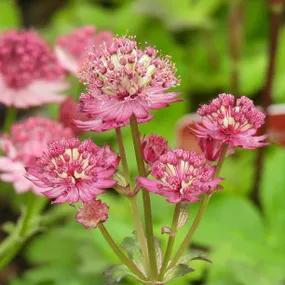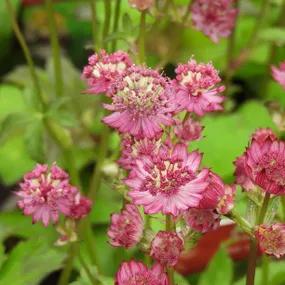Star of Beauty Masterwort Plants
The details
Astrantia major
Pot Grown Herbaceous Perennials- Greater Masterwort.
- Vivid purple, "pincushion" compound flowers.
- Flowering: June - early Sept
- Good for cutting & drying
- Foliage: Deep green
- To 60 x 50cm
- Thrives in partial shade
- Almost any soil, good beside water
- RHS Plants for Pollinators
Recommended extras
Description
Astrantia major Star of Beauty Masterwort Plants
A star of a perennial indeed: compact, shade-tolerant with purple shaded papery-star-shaped, serrated-edged flowers that have unique "pincushion" centres. This popular variety, loved by bees, has a long blooming period from June through to September. Excellent as cut flowers and for drying. To 60cm tall.
Browse our range of perennial plants.
Features
- Greater Masterwort.
- Vivid purple, "pincushion" compound flowers.
- Flowering: June - early Sept
- Good for cutting & drying
- Foliage: Deep green
- To 60 x 50cm
- Thrives in partial shade
- Almost any soil, good beside water
- RHS Plants for Pollinators
Growing Star of Beauty Masterwort
Astrantias thrive in sheltered borders with dappled shade: they only need some sun to flower well. They will grow near the coast in sheltered conditions and in the wild are found in woodlands, meadows, grasslands and by streams. They at their happiest in any well-drained soil enriched with humus, and they like moist, non-waterlogged conditions near water. Once established, the plants are drought resistant.
Cut everything back in October after the last flowers fade in order to encourage new foliage. Deadhead regularly as these are great self-seeders. It also encourages new blooms.
In Your Garden Design
You can pair them with almost anything, and they are brilliant in shady areas around ferns, hostas and hellebores, or alongside shrubs such as skimmia and under fruit trees. For more cottage gardens style arrangements, pair with Aquilegia Spring Magic and Viola Rebecca, and offset with the lime green displays of Wood Spurge.
Cultivation Instructions
Position in full sun in well-drained soil enriched with humus planting 60cm apart. Avoid spots affected by winter waterlogging. Water until established, then drought tolerant. Protect from slugs. Suitable for containers.
Apply a general fertiliser and a mulch in spring. Deadhead. Divide mature clumps in spring.



